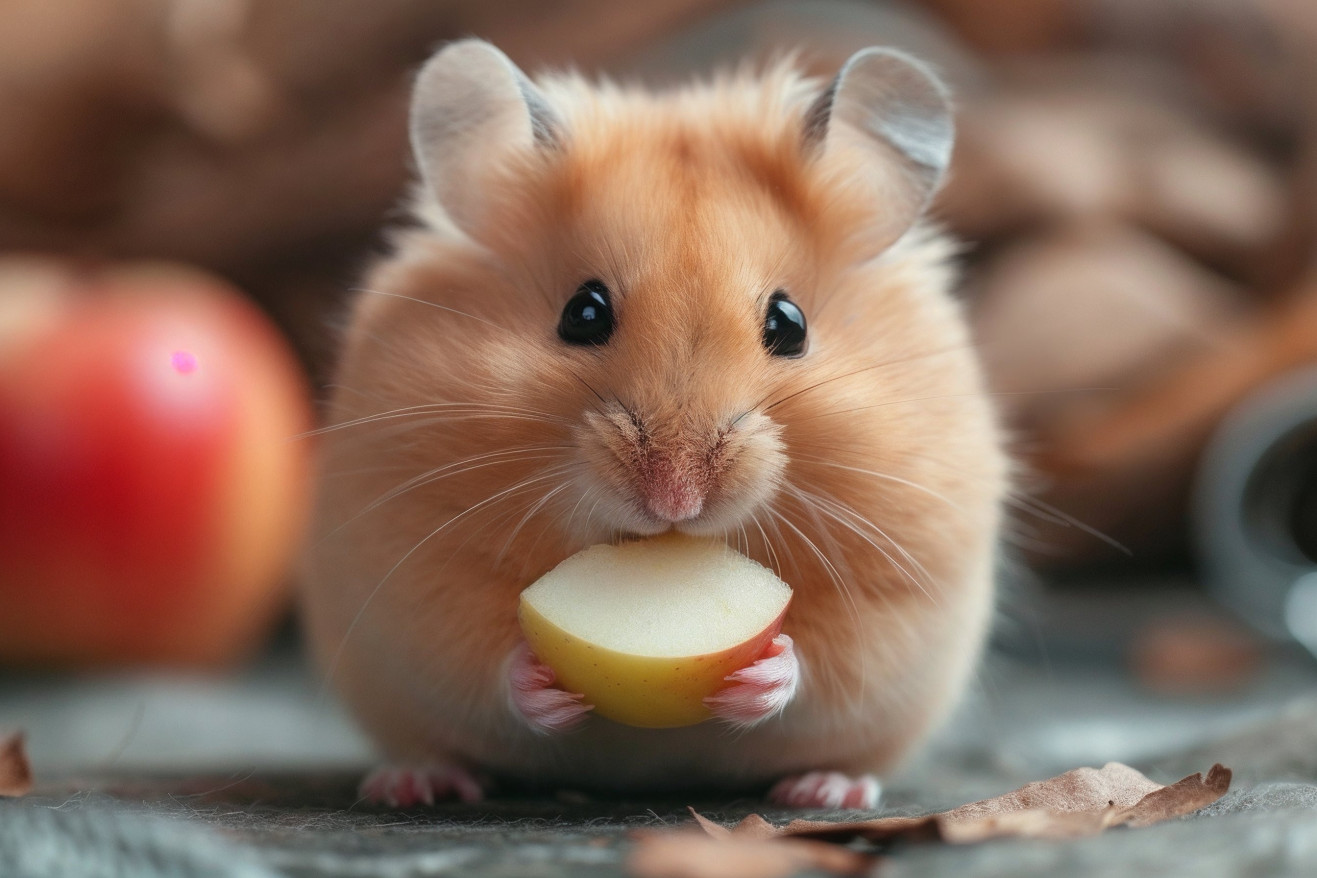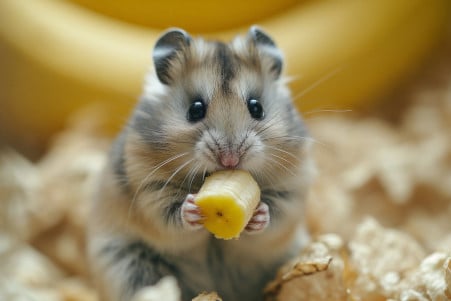Can Hamsters Have Apples? What to Know About Feeding Your Pet Fruit
31 January 2024 • Updated 6 February 2024

Apples are a staple in many homes, but can your pet hamster enjoy them as a snack? The answer is yes, hamsters can eat apples as long as they are given in moderation, are seedless, and are cut into small, bite-sized pieces to prevent choking. However, apples are high in sugar, so they should only be given to your hamster occasionally, not every day.
To better understand the role of apples in a hamster’s diet, we’ll look at the veterinary science and dietary recommendations that help shape how we take care of our pets.
We’ll also explore research on animal nutrition, including how hamsters digest fruit and the impact of sugar on their diet. This will help us better understand the pros and cons of feeding apples to hamsters and help you make informed decisions about your pet’s diet.
Can hamsters have apples?
What Do Hamsters Eat in the Wild and as Pets?
In the wild, hamsters eat a variety of seeds, grains, and insects, which provide the nutrients they need to keep up with their active lifestyles. The RSPCA explains that wild hamsters combine grains with protein, such as insect larvae and crickets. This shows that a varied diet is important for their survival and health.
For pet hamsters, it’s important to make sure that their diet is as close to what they would eat in the wild as possible. UK Pet Food explains that this means making sure that they get all of the essential nutrients and minerals that they need, which can be accomplished by feeding them specially formulated hamster foods that combine seeds and pellets and supplementing them with fresh fruit and vegetables.
However, it’s important to make sure that fruits, like apples, are fed in moderation as part of a balanced diet to avoid nutritional deficiencies or weight gain.
Fruit should be used to supplement a hamster’s staple diet by providing them with extra vitamins and fiber. That said, PDSA warns that fruit should only make up a small part of a hamster’s diet to avoid stomach upsets.
Make sure to introduce new foods slowly and stick to a regular feeding schedule to avoid health problems that can arise from sudden changes in a hamster’s diet. By knowing this information, we can make sure that our pets are healthy and happy.
The Bottom Line: Apples in a Hamster’s Diet
Pet Keen notes that apples can be especially beneficial to hamsters because of their vitamin C, which is important for preventing scurvy and supporting the immune system.
Plus, the fiber in apples can help support a hamster’s digestive system. However, it’s important to remember that apples should be used as a supplement to a well-rounded diet. Hamsters can suffer from health issues like diabetes and obesity if they eat too many apples due to their sugar content.
Petsvills stresses the importance of removing apple seeds before feeding them to your hamster to prevent choking and protect them from amygdalin, a substance in the seeds that can turn into cyanide. The Spruce Pets also notes that fruits like apples should only make up a small part of a hamster’s diet. As a general rule, a small teaspoon every other week is a good portion size to aim for.
Be sure to introduce apples into your hamster’s diet carefully to ensure that you’re getting the most out of their nutritional value while minimizing any potential health risks. Always feed apples in moderation as an occasional treat to ensure that you’re maintaining the right balance between your pet’s health and happiness.
Safe and Tasty: How to Prepare Apples for Your Hamster
You can prepare an apple for your hamster in a way that is safe and healthy by paying attention to a few key details. First, make sure to remove the core of the apple, including all of the seeds, which contain compounds that can be toxic to your pet.
Pet Keen notes that the seeds can also be a choking hazard. Then, cut the apple into small, bite-sized pieces that are easy for your hamster to eat and can be stored in their cheek pouches.
To mix things up for your hamster, you can also try different ways of serving the apple. For example, a smoothie made from a mixture of apple, banana, oats, and Greek yogurt can turn a treat into a meal, as shown in the YouTube video Breakfast with Butternut the Hamster. Or you can shred a small amount of apple and mix it in with your hamster’s regular food to give it a different texture.
It’s important to wash all fruits to remove any pesticide residues. The Spruce Pets recommends that fresh fruits and vegetables make up about 20% of a hamster’s diet and stresses the importance of keeping them clean. For an even better option, look for organic apples, which will help reduce your hamster’s exposure to potentially harmful substances and ensure that the treats you’re giving them are of the highest quality.
How the Hamster’s Digestive System Works and the Role of Fruit
The hamster’s digestive system is well-suited to its omnivorous diet. According to Science World, the digestive process involves coprophagy, or the consumption of soft feces, to reabsorb nutrients, which is an important part of the digestion of cellulose from plant material.
The caecum, which is similar to the human appendix, is essential to this process. Microbes in the caecum ferment cellulose to produce sugars that the hamster can use for energy, allowing the hamster to get the most out of the food it eats.
In the metabolism of fruits like apples, the microbial fermentation in the caecum is especially important.
According to a study in the Journal of Animal Science, fermentation takes place in the pregastric area, which results in the production of volatile fatty acids that are used for energy.
However, the high sugar content of fruits can lead to digestive upset, so it’s important to feed them in moderation.
Zooplus Magazine explains that while the small intestine is the primary site of digestion, a well-rounded diet is important for the overall health of the digestive system, which can help prevent problems like diarrhea and constipation.
In light of these details, it’s important for hamster owners to make sure they’re controlling the amount and frequency of fruit in their hamster’s diet. By feeding hamsters small amounts of apple as an occasional treat, hamster owners can make sure their pets get the benefits of the fruit without overloading their digestive systems.
The Best Apple Varieties for Your Hamster
When choosing apples for your hamster, the most important thing to keep in mind is the sugar content. Different apple varieties have different levels of sugar, and this can make a big difference in your hamster’s diet.
Nutrition Advance has a great breakdown of the sugar content of some of the most popular apple varieties. For example, Braeburn and Fuji apples have a higher sugar content, which means they’re not the best choice for your hamster.
Look for apple varieties that have a naturally lower sugar content, like Granny Smith apples. These apples are tart and have a lower sugar content, which means they’re a better choice for hamsters that are at risk for diabetes or obesity, according to research from Nutrition Advance. While sweeter apple varieties like Ambrosia or Honeycrisp may be more tempting, they should be fed in moderation because of their higher sugar content.
By including a variety of apple varieties, especially those that have a lower sugar content, you can make sure that your hamster’s diet is well-rounded. Make sure to introduce new foods slowly so you can see how your hamster reacts to them, as recommended by The Spruce Pets.
By making sure to choose the right apple varieties and feed them in moderation, you can make sure that you’re giving your hamster treats that they’ll love without putting their health at risk.
Conclusion: Can Hamsters Eat Apples?
In conclusion, hamsters can eat apples as long as they are given to them as a treat and in the right way. The most important things to remember are to feed apples to your hamster in moderation and to prepare them properly, which means removing the seeds, cutting them into small pieces, and washing them to remove any pesticides.
It’s also a good idea to choose apple varieties that are lower in sugar to avoid health problems like diabetes and obesity.
We hope that hamster owners will take a responsible and cautious approach to feeding their pets fruit. By following the recommendations outlined in this article, you can enjoy the adorable sight of your hamster eating a slice of apple without worrying about their health. It’s important to find a balance between the nutritional value of these fruits and the potential problems that can arise from overfeeding them.
In conclusion, always remember that your pet’s well-being is in your hands. Feeding your hamster apples as part of a varied and nutritious diet will help ensure that they live a long and healthy life, which will lead to many happy moments with your little friend.


